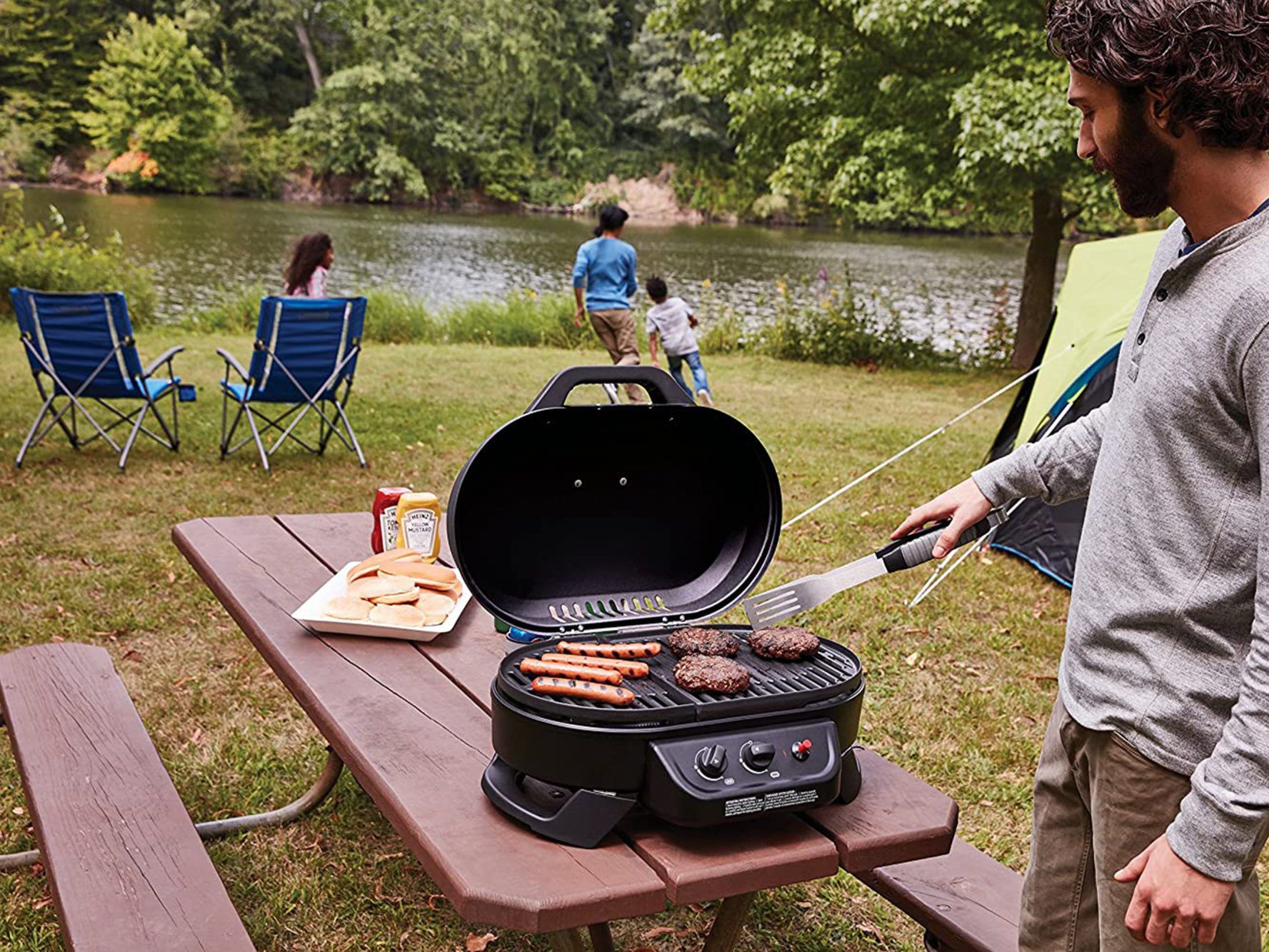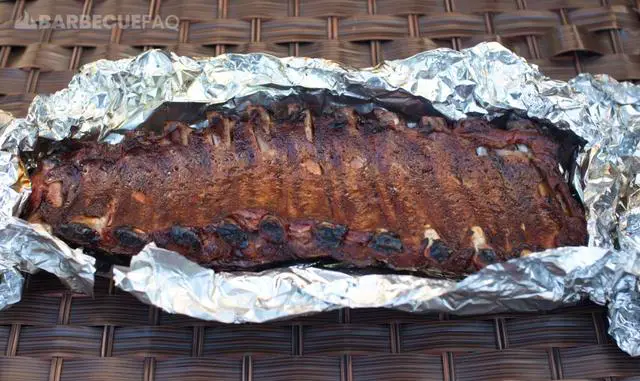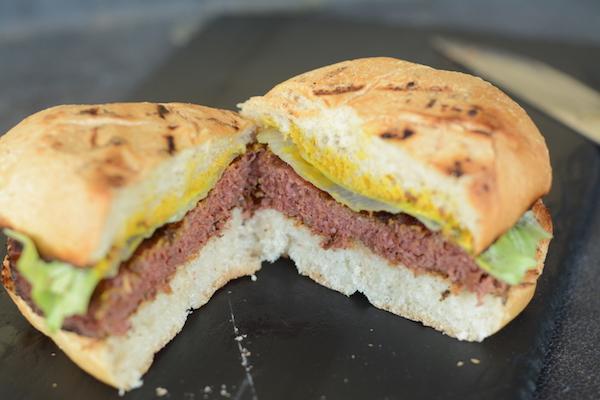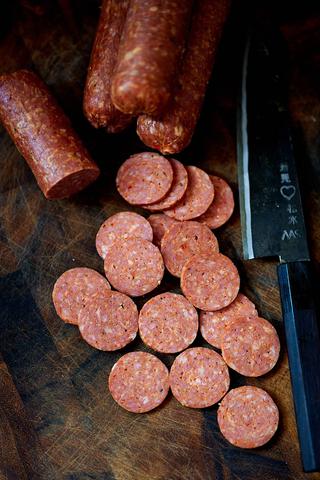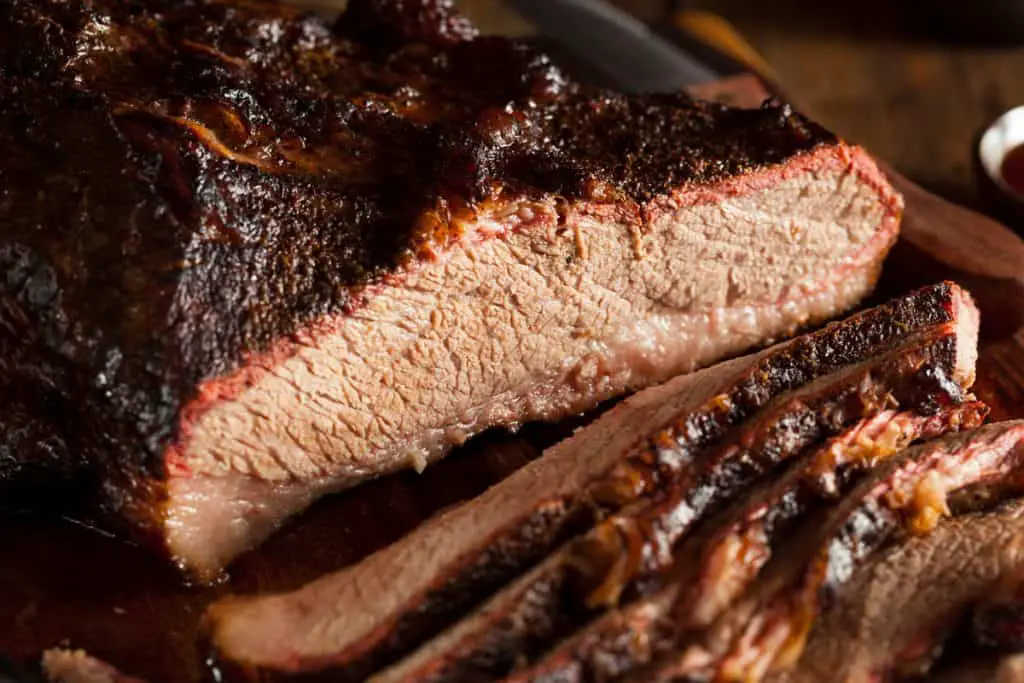
“Tri Tip vs Brisket: Unveiling the Ultimate Battle of Flavors and Textures. Discover the key differences between these two beloved cuts of meat and find out which one reigns supreme on your plate. Get ready to savor a mouthwatering journey as we explore their unique characteristics, cooking methods, and delicious serving suggestions. Let your taste buds be the judge in this epic culinary showdown!”
Tri Tip vs Brisket: What’s the Difference?
The primary difference between tri-tip and brisket is their location on the cow. Tri-tip is taken from the hindquarter, specifically from the bottom of the sirloin, while brisket is taken from the forequarter, which is the chest musculature of the cow.
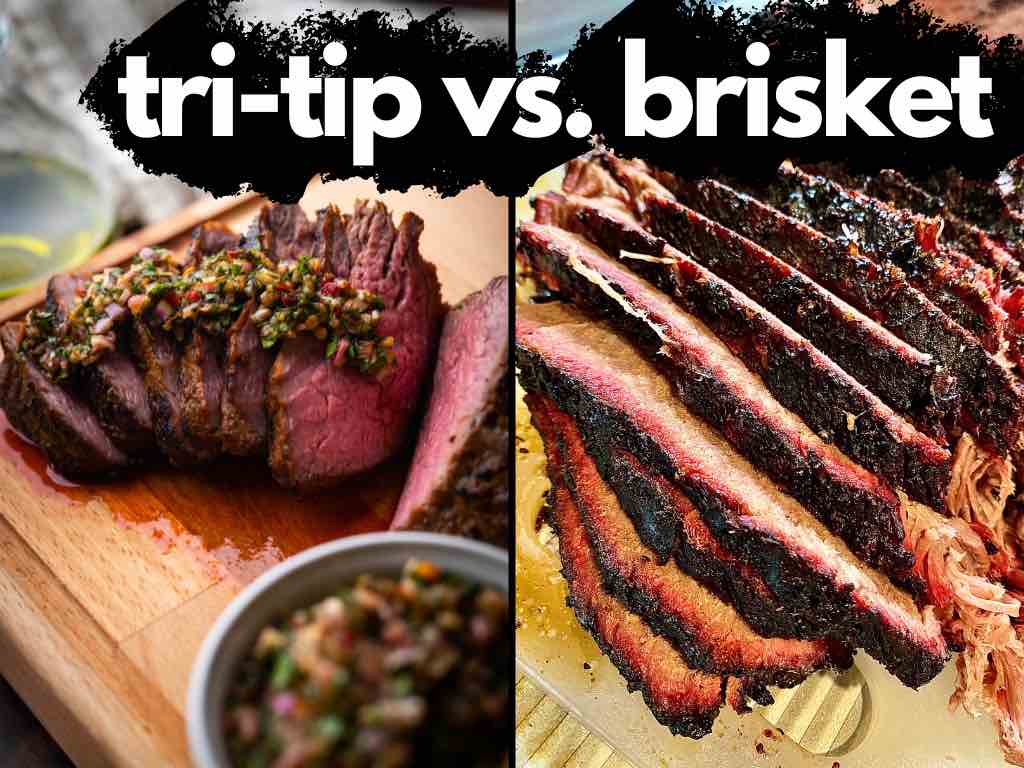
Another key difference between tri-tip and brisket is their size and fat content. Brisket is a rather large cut of meat, weighing 8-20 lbs, and has extensive intramuscular fat marbling. On the other hand, tri-tip is a leaner cut that typically weighs 4-6 lbs.
When it comes to cooking methods, brisket is best prepared through a long smoking process that can take 12+ hours to render collagen and fat. On the other hand, tri-tip is best served as a steak and can be reverse seared by smoking for about an hour until reaching an internal temperature of 130-135F, followed by searing over high heat for 30-60 seconds on each side.
Tri Tip vs Brisket: Basic Differences
The primary difference between tri-tip and brisket is the location of the cut on the cow. Tri-tip is taken from the hindquarter, specifically the bottom sirloin, while brisket is taken from the forequarter, specifically the chest musculature. This difference in location results in differences in size and fat content.
Brisket is a large cut of meat, weighing 8-20 lbs, with extensive intramuscular fat marbling. It is made up of two muscles – the point and the flat – that have opposite grain directions. On the other hand, tri-tip is a relatively lean cut weighing 4-6 lbs. It is a sub-primal of the bottom sirloin and has a singular grain direction that transitions in the middle.
What is Beef Brisket?
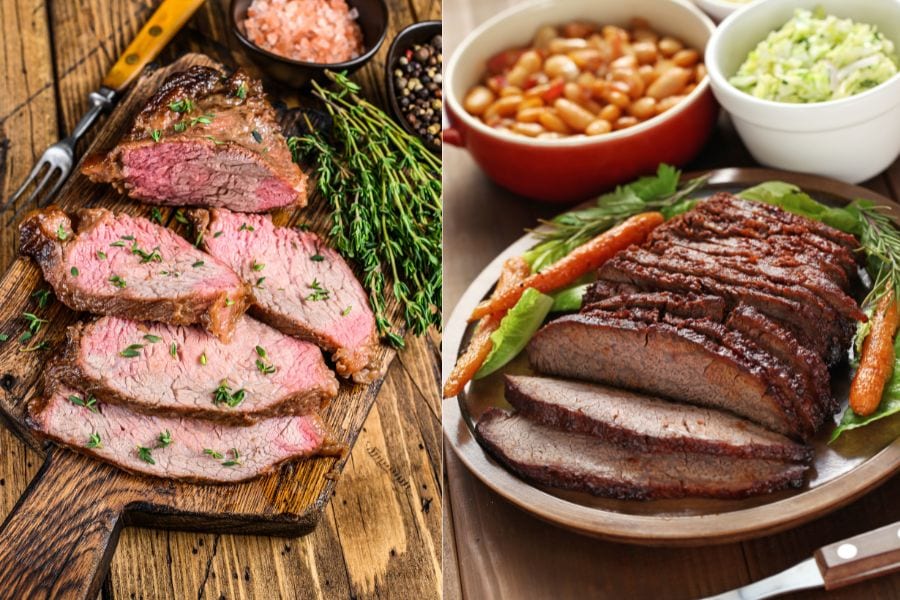
Beef brisket is a large cut of meat taken from the chest musculature of the cow, specifically the forequarter. It is a tough cut of meat due to the presence of fibrous connective tissues and collagen. Brisket is known for its extensive intramuscular fat marbling, which adds flavor and moisture to the meat when cooked properly. It can weigh anywhere from 8-20 lbs and is commonly divided into two distinct cuts: the flat cut and the point cut.
Cooking beef brisket requires a low and slow method in order to break down the tough connective tissues and render the fat. The ideal cooking temperature for brisket is between 225-275F, and it should be cooked for approximately 1.5-2 hours per pound of meat. It is important to trim off excess fat before seasoning, but leaving a thin layer of fat on top helps keep the meat moist during cooking. Brisket can be seasoned with various rubs or spices according to personal preference.
When buying brisket, it is important to look for fatty striations throughout the meat, as this indicates good marbling. A trimmable fat cap, an even flat muscle, and avoiding shoddy butcher work are also desirable qualities in a good brisket. Opting for choice or prime grade briskets can make decision-making easier. A good size for a brisket is between 8-10 lbs, making it suitable for most smokers.
How to Prepare Brisket
Preparing brisket requires careful attention and a slow cooking process to ensure tenderness and flavor. Here are the steps to prepare brisket:
1. Trim the Brisket: Start by trimming any excess fat from the brisket when it is cold. This will make it easier to handle and allow for more even cooking.
2. Season the Meat: Before seasoning, pat dry the meat with paper towels to remove any excess moisture. Then, choose your favorite rub or seasoning blend. A simple combination of kosher salt, black pepper, and garlic powder works well for enhancing the natural flavors of brisket.
3. Optional Dry Brining: If desired, you can let the seasoned brisket sit in the refrigerator for a few hours or overnight. This allows the salt in the rub to penetrate the meat and enhance its flavor.
4. Preheat and Smoke: Preheat your smoker to a temperature between 225-275 degrees Fahrenheit. Place the brisket on the smoker grates, fat side up, and close the lid. Slow cook the brisket until it reaches an internal temperature of around 195-205 degrees Fahrenheit.
5. Test for Tenderness: While internal temperature is important, probe tenderness is key when determining if your brisket is done. Use a meat thermometer or probe to check for tenderness by inserting it into different parts of the meat. The probe should slide in easily with little resistance.
6. Rest and Slice: Once your brisket is cooked and tender, remove it from the smoker and let it rest for at least 30 minutes before slicing. This allows the juices to redistribute throughout the meat, resulting in a juicy end product.
7. Slice Against Grain: When ready to serve, slice your brisket against the grain. This means cutting perpendicular to the long muscle fibers of the meat, which helps break up any toughness and maximize tenderness.
8. Serve and Enjoy: Arrange the sliced brisket on a platter and serve it as a main course with your favorite barbecue sauce or other accompaniments. Brisket pairs well with sides such as coleslaw, cornbread, and baked beans.
By following these steps, you can prepare a delicious and tender brisket that is sure to impress your family and friends.
How to Smoke Brisket
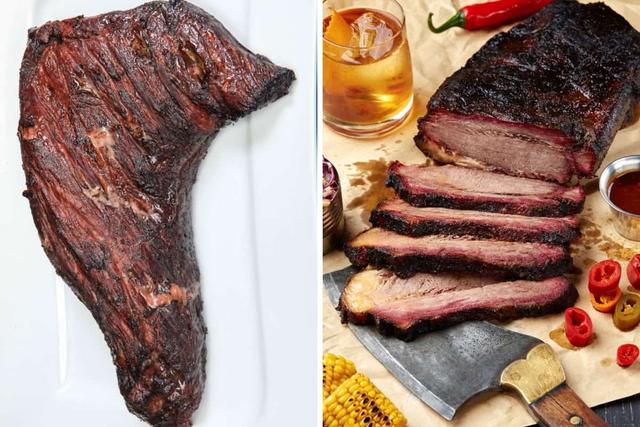
Smoking brisket is a long and slow process that requires patience and careful preparation. Here are the steps to smoke a delicious brisket:
1. Trim the brisket: Start by trimming any excess fat from the brisket when it is cold. This will make it easier to work with. Remove any fat nodules and pat dry the meat with paper towels.
2. Season the brisket: Choose your favorite rub or seasoning mix for the brisket. A simple combination of salt, pepper, and garlic works well for beginners. Apply the rub generously all over the brisket, making sure to cover every surface.
3. Let it rest (optional): You can choose to let the seasoned brisket sit in the refrigerator for a few hours or even overnight. This allows the salt in the rub to penetrate into the meat and enhance its flavor. However, this step is optional.
4. Preheat your smoker: Prepare your smoker by preheating it to a temperature between 225-275 degrees Fahrenheit. Consistent low steady heat is crucial for smoking a tender and flavorful brisket.
5. Smoke the brisket: Once your smoker is at the desired temperature, place the seasoned brisket on the grates, fat side up. Close the lid and let it smoke until the internal temperature reaches around 125 degrees Fahrenheit. This usually takes about an hour per pound of meat.
6. Sear the meat (optional): After smoking, you can choose to sear the brisket on a hot grill or skillet to develop a crust on both sides of the meat. Sear each side for approximately 45-60 seconds.
7. Check for doneness: The ideal internal temperature for a smoked brisket is between 195-205 degrees Fahrenheit. However, the best way to determine if it’s done is by checking for probe tenderness. Use a meat thermometer or probe to ensure the brisket is tender and easily pierced.
8. Rest and slice: Once the brisket reaches the desired doneness, remove it from the smoker and let it rest for at least 30 minutes before slicing. This allows the juices to redistribute throughout the meat, resulting in a more flavorful and tender brisket.
9. Slice and serve: When ready to serve, slice the brisket against the grain to minimize fiber length. Serve hot and enjoy!
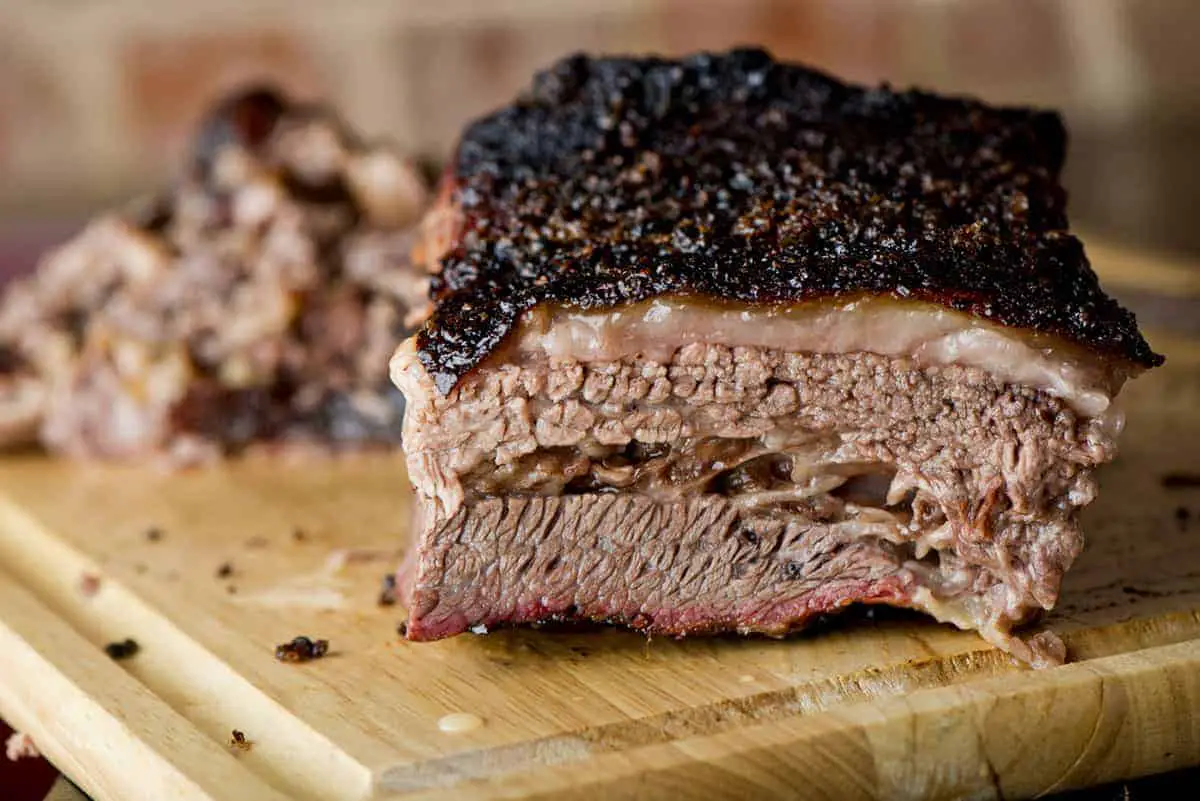
What is Tri-Tip?
Tri-tip is a cut of beef that is taken from the bottom sirloin of the cow. It is also known as the “bottom sirloin butt” and “triangle roast” due to its triangular shape. This cut of beef is lean and weighs around 4-6 lbs. Tri-tip is considered one of the most flavorful cuts of beef and is popular in the Western part of the United States, particularly in California. It can be prepared as a steak and is often smoked using a reverse sear method.
How to Prepare Tri-tip
Preparing tri-tip is relatively simple and can be done in a few steps. Here is a basic guide on how to prepare tri-tip:
1. Start by seasoning the tri-tip with your favorite rub or marinade. Common seasonings include salt, pepper, garlic, and various herbs and spices.
2. Let the tri-tip marinate for a few hours or overnight in the refrigerator to enhance the flavor. This step is optional but can result in more flavorful meat.
3. Preheat your grill or smoker to medium-high heat (around 400-450°F).
4. Place the tri-tip on the grill or smoker and cook for about 20-30 minutes per pound, or until it reaches your desired level of doneness. The internal temperature should be around 130-135°F for medium-rare.
5. Once cooked, remove the tri-tip from the grill and let it rest for about 10 minutes before slicing.
6. Slice the tri-tip against the grain into thin slices for maximum tenderness.
7. Serve and enjoy!
– Keep an eye on the internal temperature of the tri-tip using a meat thermometer to ensure it does not overcook.
– Letting the tri-tip rest after cooking allows the juices to redistribute, resulting in a juicier and more tender steak.
– Experiment with different rubs, marinades, and flavors to find your favorite combination.
– Tri-tip can be enjoyed as a standalone dish or used in various recipes such as sandwiches, tacos, salads, or stir-fries.
– Pair tri-tip with your favorite side dishes like roasted vegetables, mashed potatoes, or a fresh green salad.
– Serve tri-tip with a flavorful sauce or gravy for added taste and moisture.

How to Smoke Tri Tip
Smoking tri-tip is a popular method of cooking this flavorful cut of meat. Here are the steps to smoke tri-tip:
1. Start by preparing your smoker. Preheat it to a temperature of 225-275 degrees Fahrenheit.
2. While the smoker is heating up, prepare the tri-tip by trimming off any excess fat nodules and patting it dry with paper towels.
3. Season the tri-tip with your desired rub or seasoning. A simple combination of kosher salt, pepper, and garlic works well for enhancing the natural flavors of the meat.
4. If you have time, you can let the seasoned tri-tip sit in the refrigerator for a few hours or even overnight to allow the salt to dry brine the meat. This step is optional but can enhance the flavor and tenderness of the final product.
5. Once your smoker has reached the desired temperature, place the seasoned tri-tip directly on the grates.
6. Smoke the tri-tip until it reaches an internal temperature of around 125 degrees Fahrenheit. This usually takes about an hour, but cooking times may vary depending on your specific smoker and size of the tri-tip.
7. After reaching the desired internal temperature, remove the tri-tip from the smoker and sear it over high heat on a grill or stovetop for approximately 45-60 seconds on each side. This will help develop a flavorful crust on the outside of the meat.
8. Once seared, remove from heat and let the tri-tip rest for a few minutes before slicing againstthe grain into thin slices.
9. Serve and enjoy your delicious smoked tri-tip!
Final Thoughts
In conclusion, tri-tip and brisket are both delicious cuts of beef but have distinct differences. Tri-tip is a lean cut taken from the hindquarter of the cow, while brisket is a larger and tougher cut taken from the forequarter. The preparation methods for these cuts also differ, with brisket requiring long hours of smoking to render collagen and fat, while tri-tip is best served as a steak.
When it comes to flavor and texture, both cuts offer unique qualities. Tri-tip is naturally tender and flavorful, making it a popular choice on the West coast. Brisket, on the other hand, is known for its extensive intramuscular fat marbling and requires slow cooking to break down tough connective tissues.
Ultimately, the choice between tri-tip and brisket depends on personal preference and cooking style. Whether you prefer a leaner cut like tri-tip or enjoy the rich flavors of brisket, both can be cooked to perfection with the right techniques.
In summary, both tri tip and brisket are delicious cuts of meat with their own unique characteristics. Tri tip is leaner and cooks faster, offering a tender and flavorful option for grilling. On the other hand, brisket is known for its rich marbling and slow-cooking method, resulting in a melt-in-your-mouth texture. Ultimately, the choice between these two cuts depends on personal preference and cooking style.
Learn More About Grilling
If you want to learn more about grilling, check out these other helpful resources!

